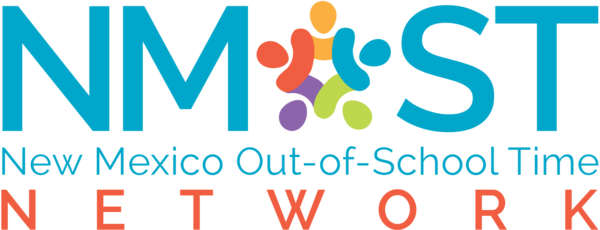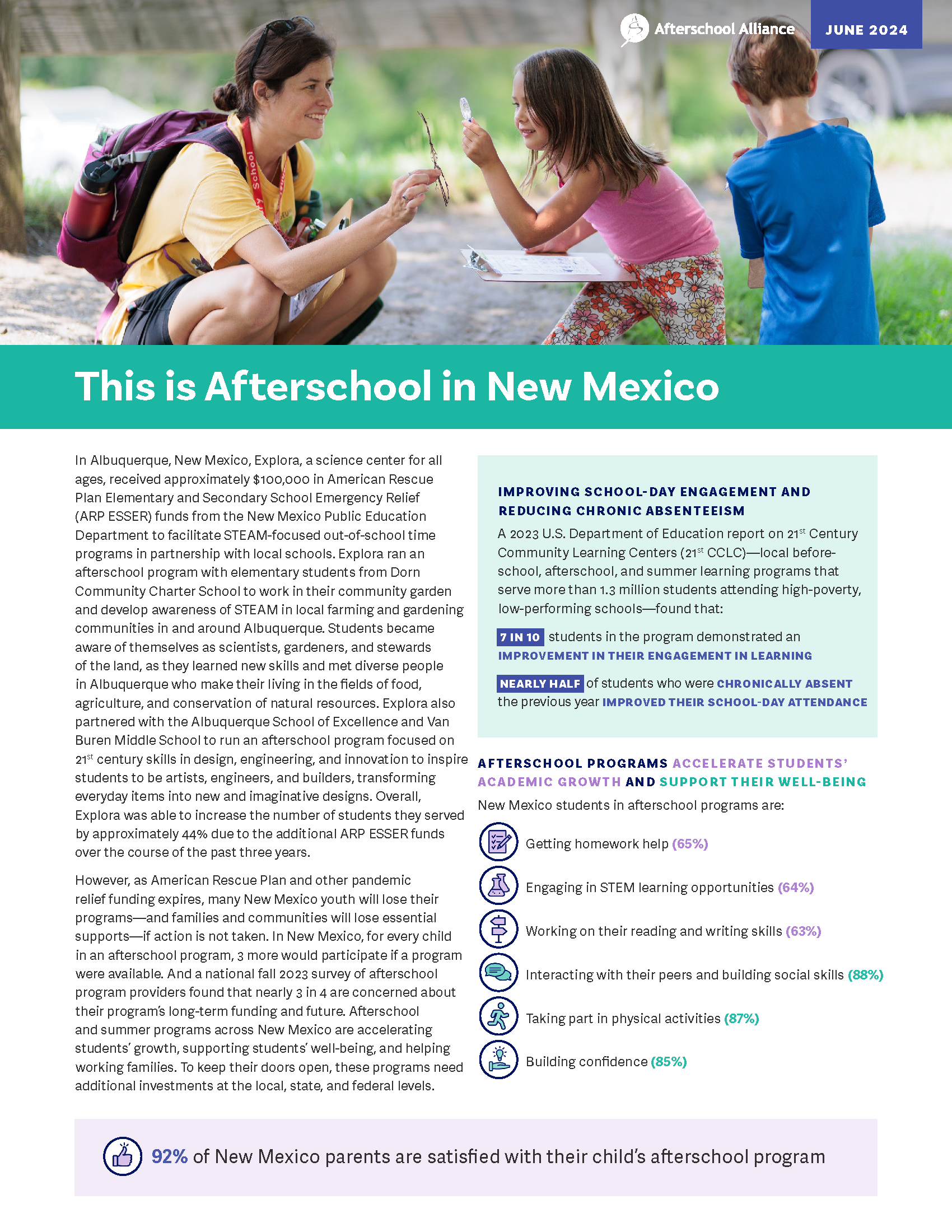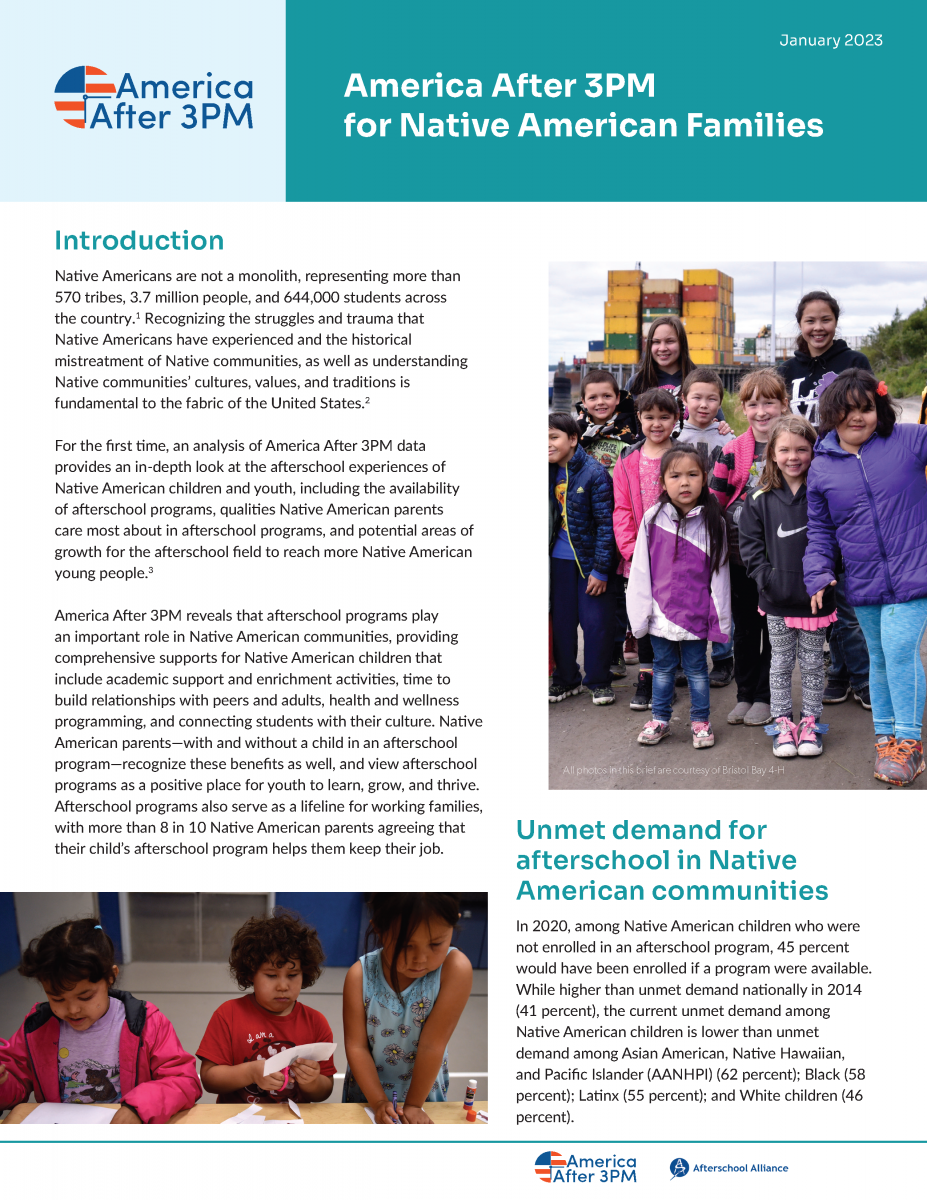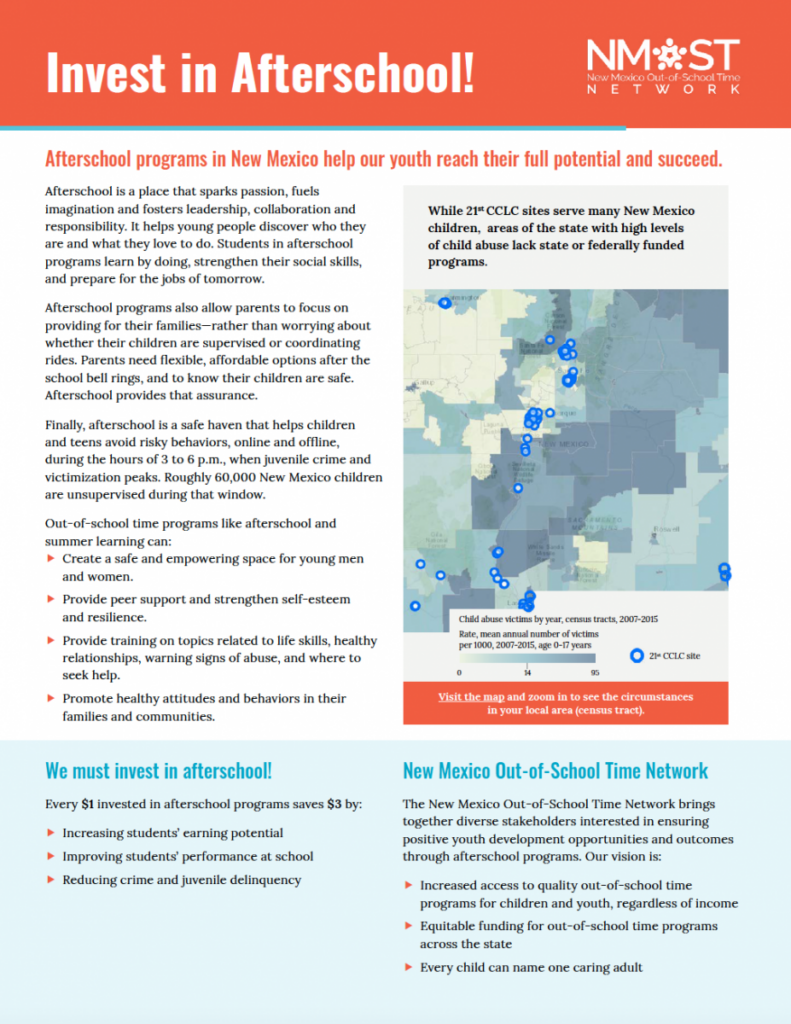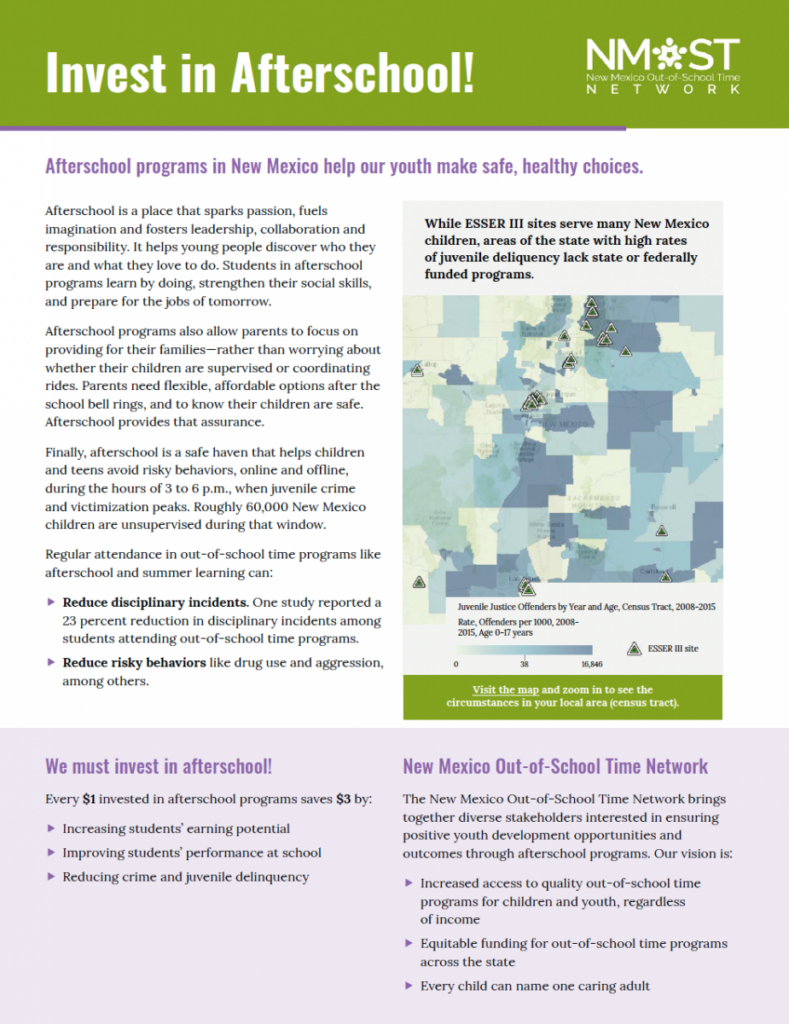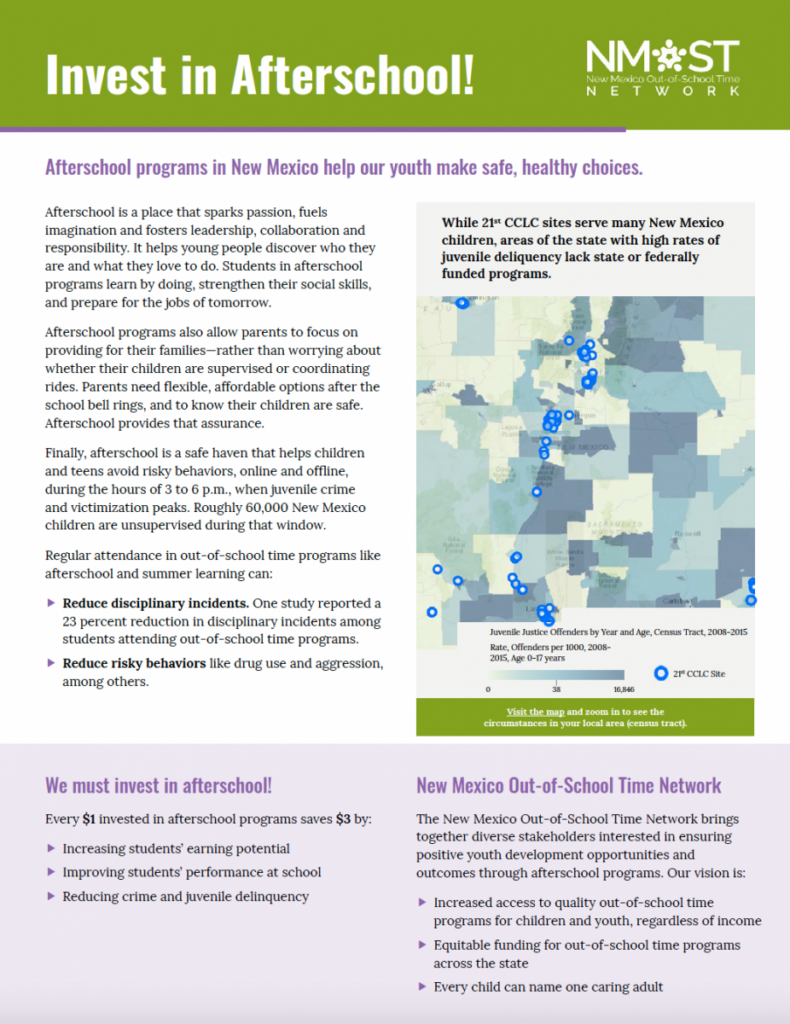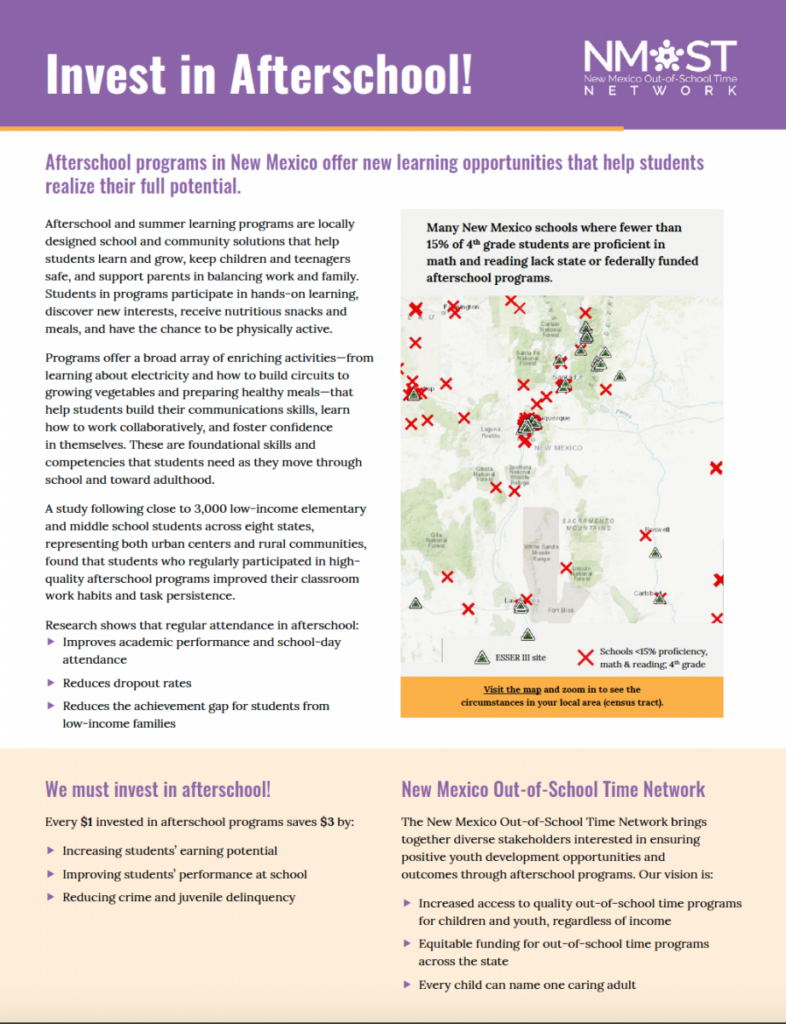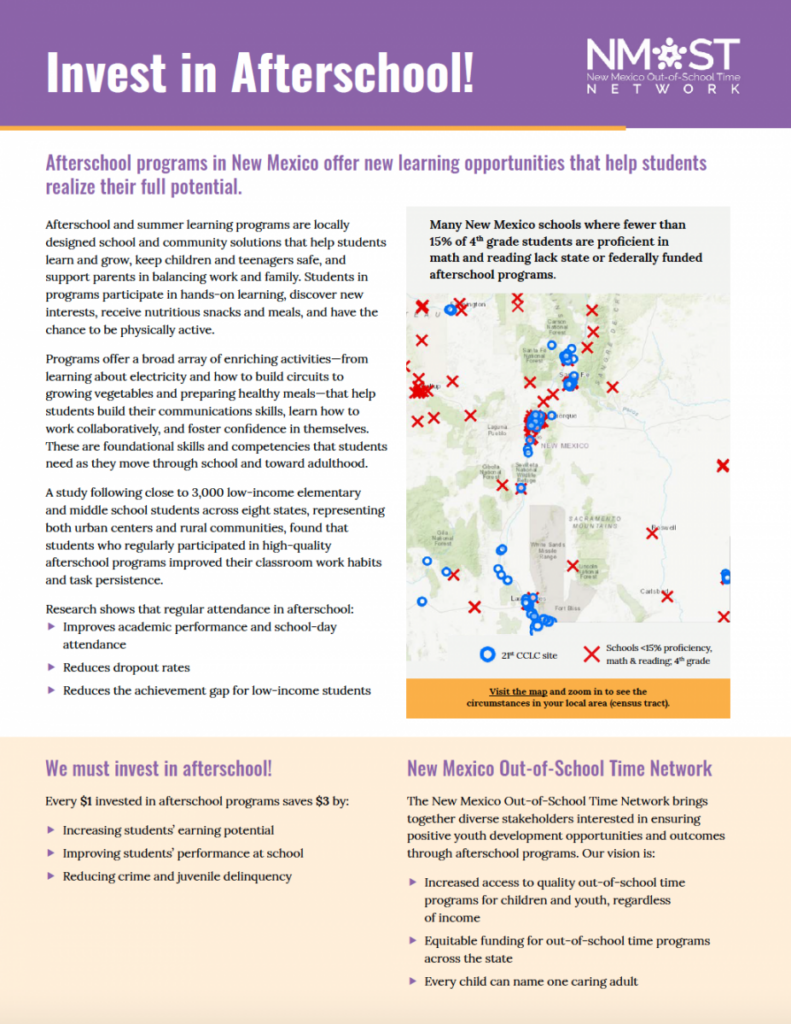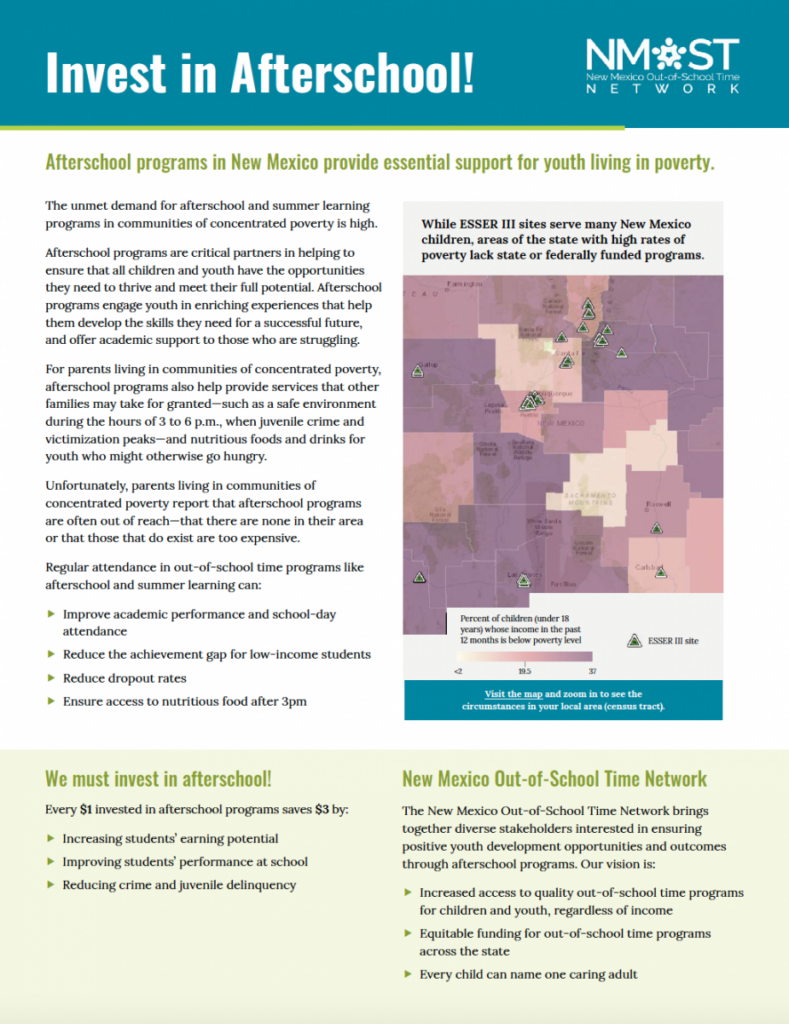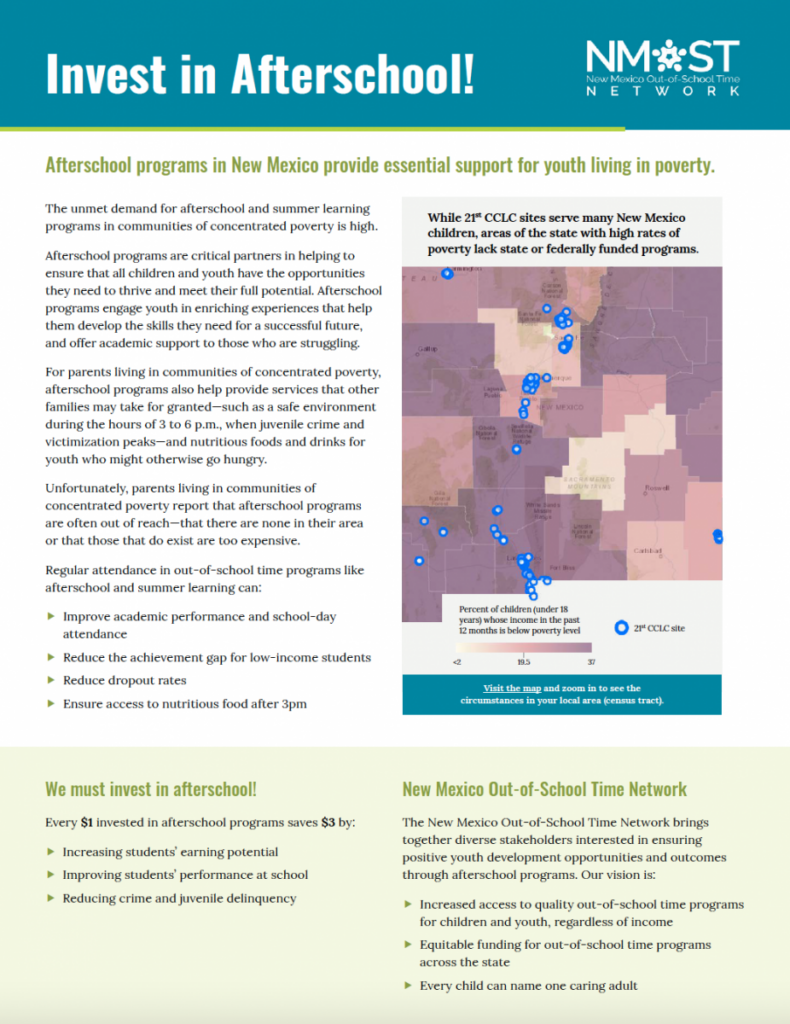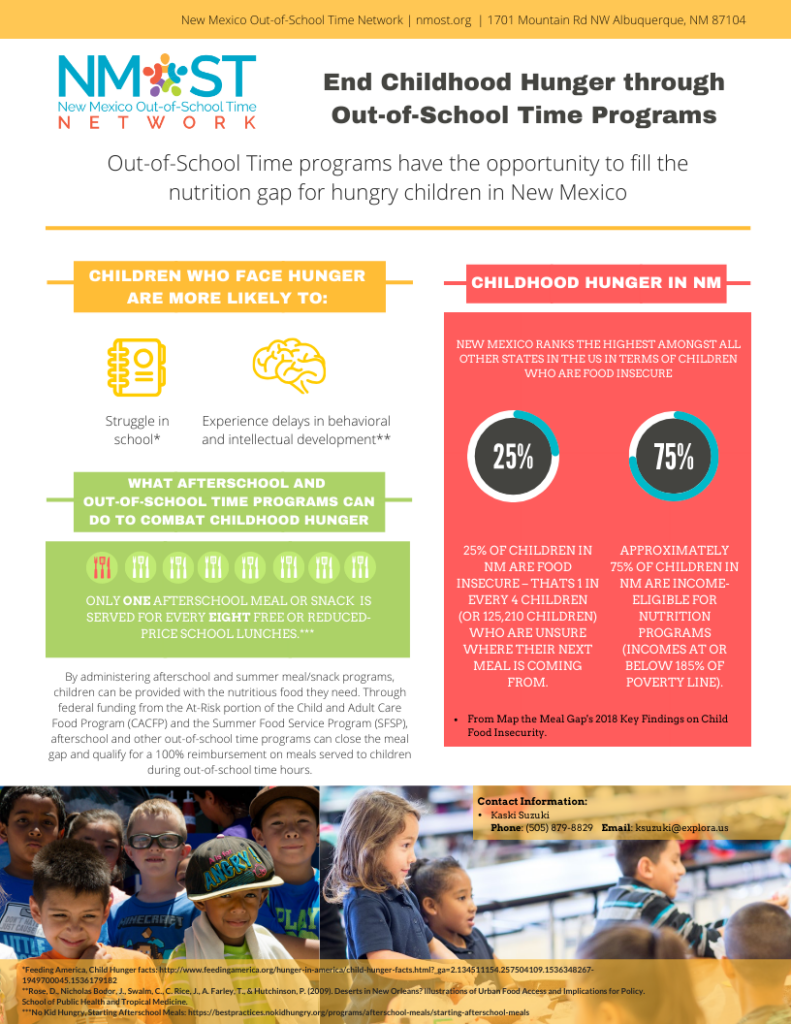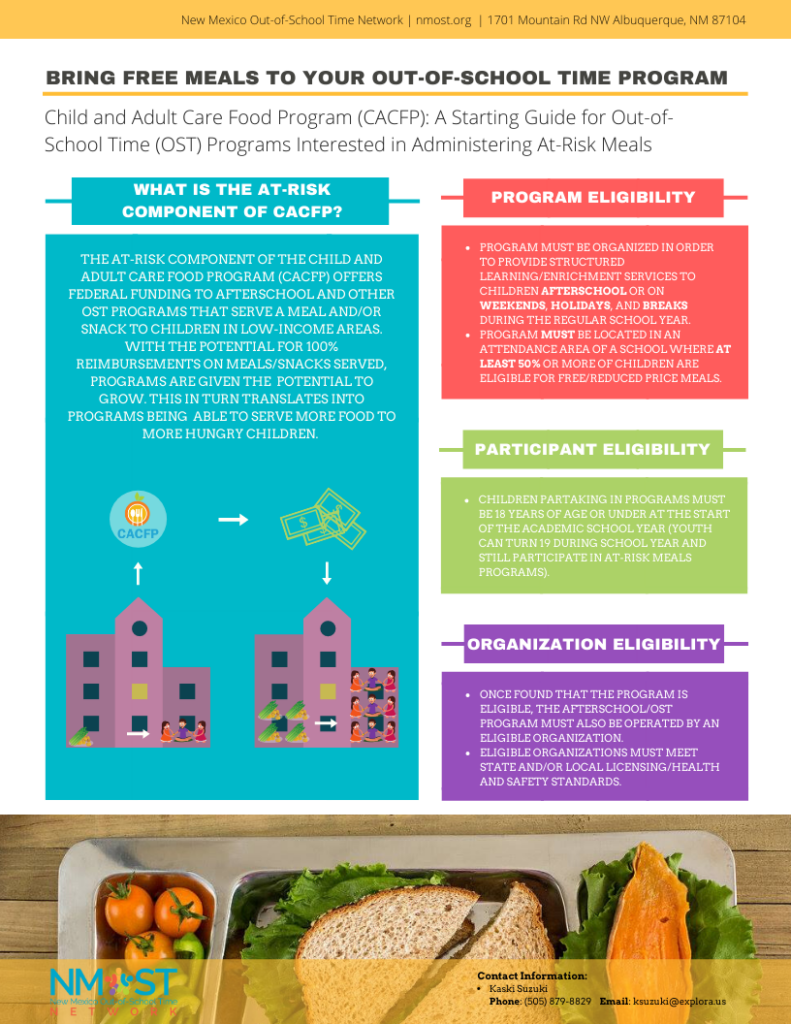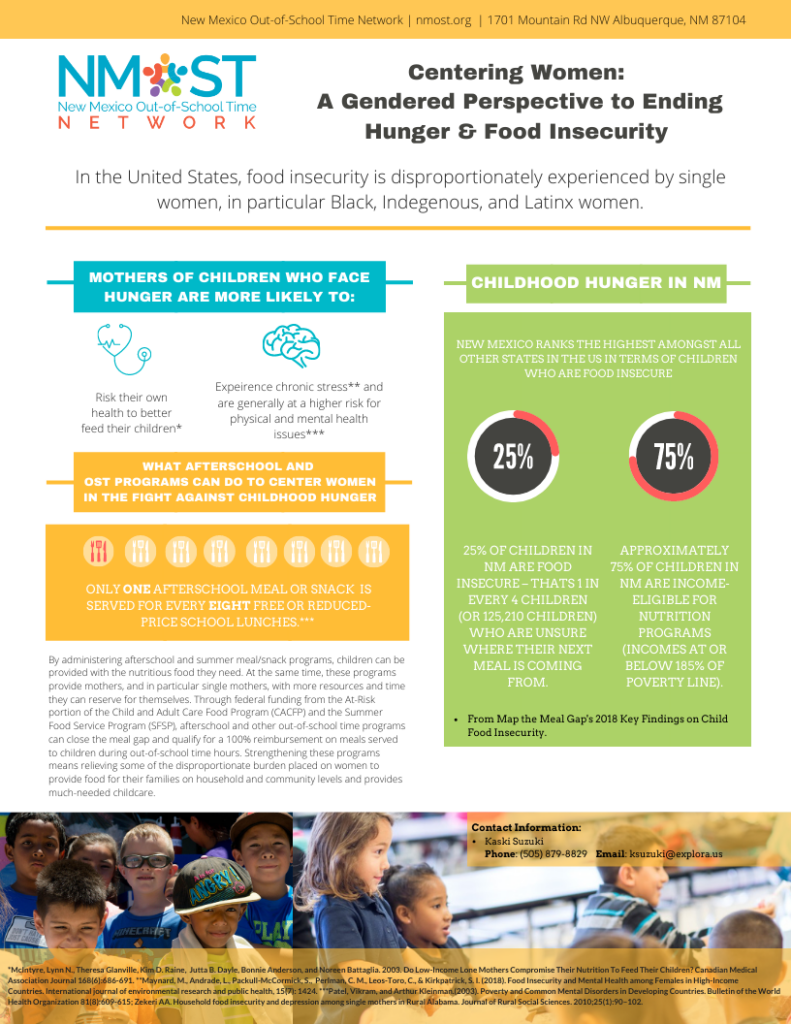Infographics
Infographics to help tell the story of out-of-school time in New Mexico. Click the images to view and/or download PDFs to post, pin or tweet to help spread the word about the demand, need & support for afterschool programs!
General Research
American Institute for Research
The American Institutes for Research® (AIR) is a nonpartisan, not-for-profit organization that conducts behavioral and social science research and delivers technical assistance to solve some of the most urgent challenges in the U.S. and around the world. We do this work because when we look to the future, we see opportunities to close gaps that are rooted in injustice. At AIR, we know that equity begins with systems that work for everyone, so we lead with expertise, follow the evidence, and never stop drawing new connections to build a better, more equitable world. AIR conducts and publishes research across a broad range of topics, including education. Some education-focused topics of particular attention include:
Rand Corporation Report - The Value of Out-of-School Time Programs
To better understand the value and effectiveness of out-of-school-time (OST) programs, RAND researchers examined programs through the lenses of content, dosage (the hours of content provided), and outcomes measured, focusing on rigorous (i.e., experimental or quasi-experimental) large-scale evaluations and meta-analyses.
Youth Today: Out-of-School Time Research, Resources & Webinar Hub
Welcome to the Youth Today Out-of-School Time (OST) Hub. The OST Hub, funded, in part, by a generous grant from the Robert Bowne Foundation, embodies the Foundation’s philosophy of positive youth development, the importance of reflection and inquiry, a deep respect for youth workers as experts in their own right and of youth worker voices. In addition, the Hub reflects the Foundation’s belief in the critical importance of building bridges between research and practice.
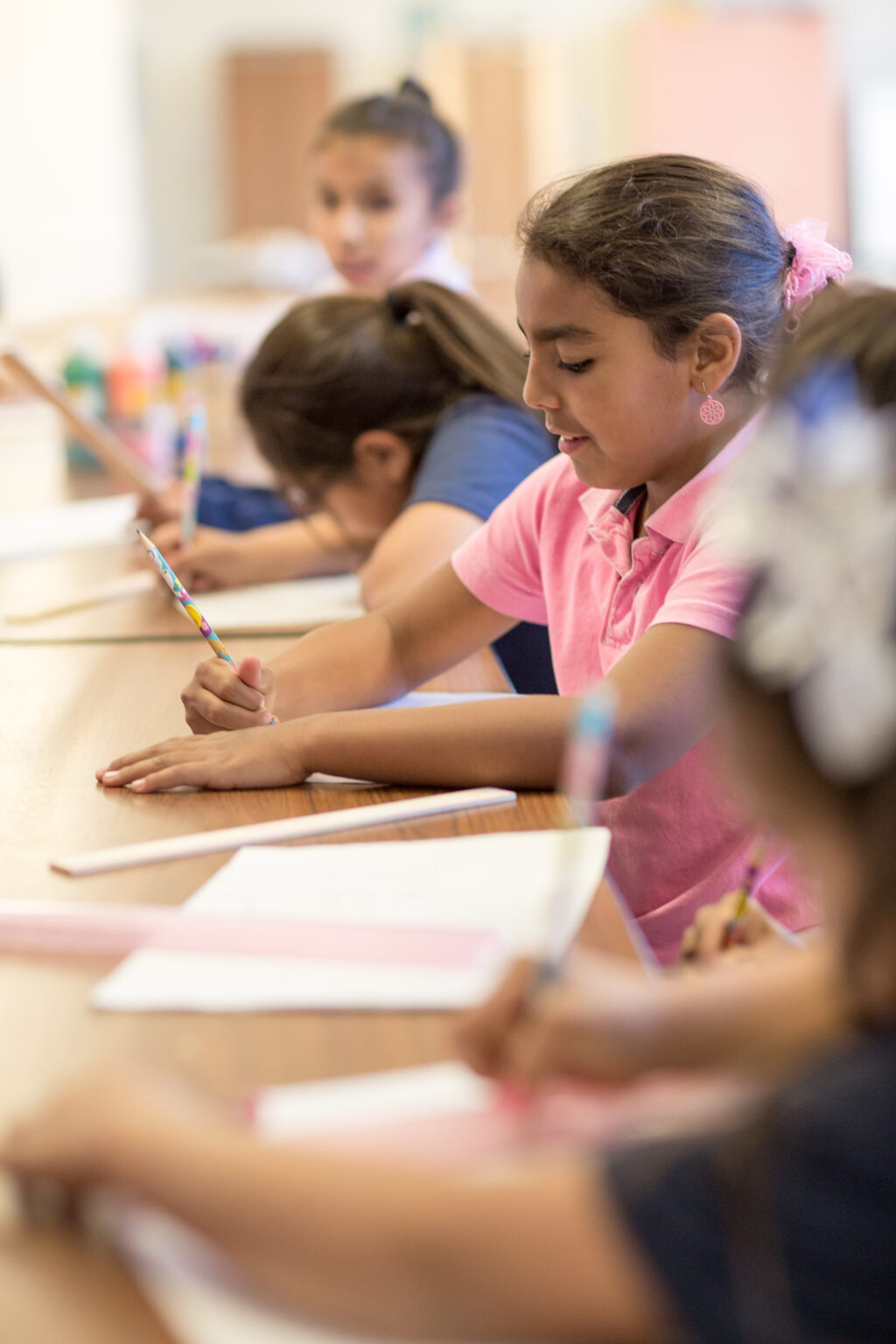
America After 3 PM
Every 5-6 years, the Afterschool Alliance commissions a series of household surveys to assess parental support for afterschool programs. The study released in 2020 shows that more New Mexico parents want afterschool programs for their children than are able to access them. It finds that, by overwhelming margins, parents express strong, broad-based support for afterschool programs. But unmet demand – the percentage of children in New Mexico not currently in an afterschool program whose parents say they would be enrolled if an afterschool program were available to them – has increased over the past six years, with low-income families in particular citing cost as a barrier to enrolling their children. As a result, for every child in an afterschool program in New Mexico today, three more are waiting to get in.
“While we are incredibly pleased that parents express such strong support for the afterschool programs their children attend, we recognize the urgent need to broaden opportunity and make afterschool programs available to many more children and youth here in New Mexico,” said May Sagbakken, Executive Director of the New Mexico Out-of-School Time Network
Research on Literacy and Out-of-School Programming
Imbedding Adolescent Literacy in Out-of-School-Time Programs
How can structured out-of-school (OST) time programs provide more support to students and schools in advancing literacy skills? How might these programs incorporate adolescent literacy development activities, while preserving their unique youth development approach?
Imbedding Adolescent Literacy in Out-of-School-Time Programs
How can structured out-of-school (OST) time programs provide more support to students and schools in advancing literacy skills? How might these programs incorporate adolescent literacy development activities, while preserving their unique youth development approach?
Outcomes
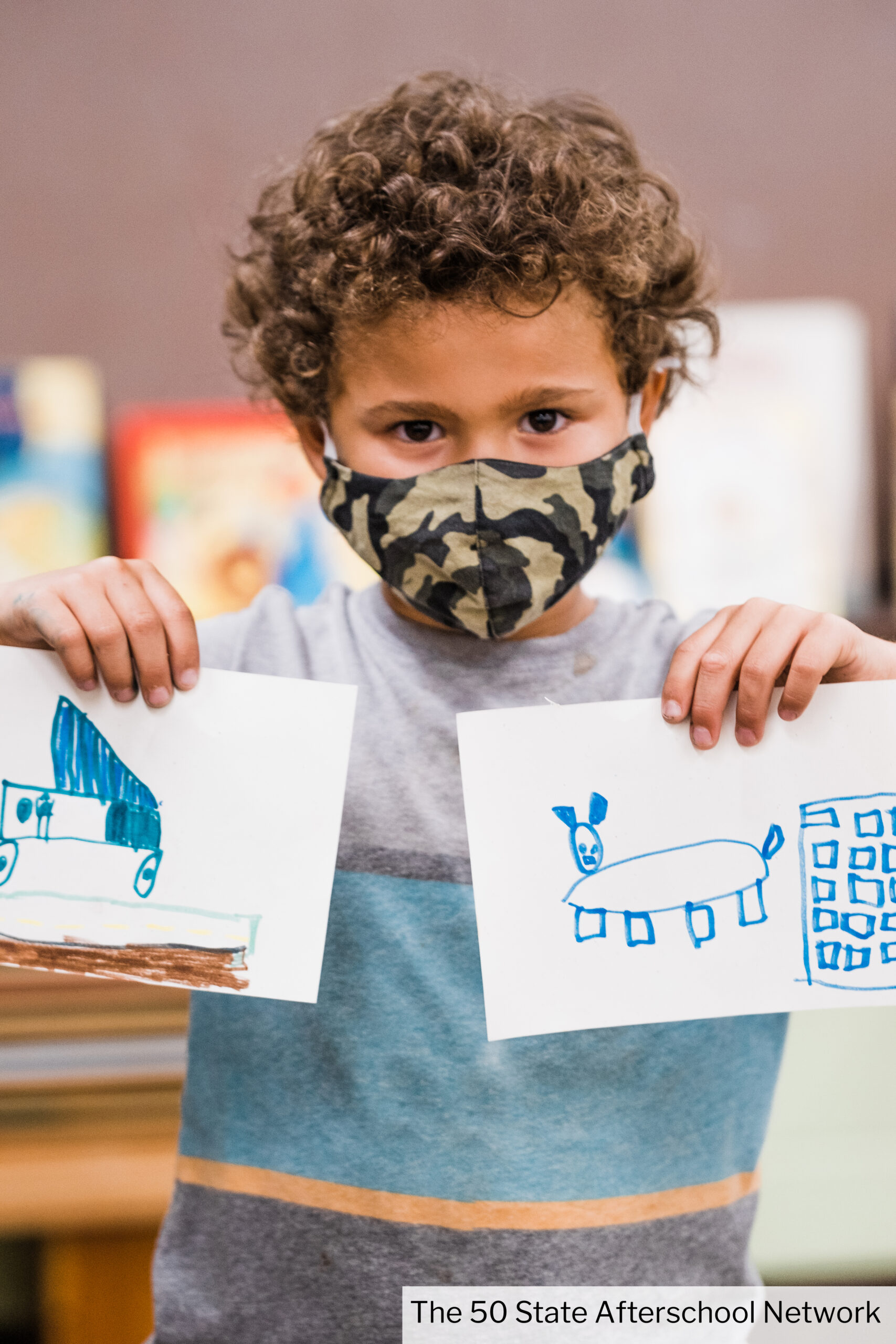
Afterschool Outcomes (2009)
National, state and local evaluations are providing evidence of the impact afterschool and summer programs have on academic outcomes for students. Download PDF
Evaluations Backgrounder: A Summary of Formal Evaluations of Afterschool Programs' Impact on Academics, Behavior, Safety and Family Life
A steady stream of afterschool evaluations are showing important gains for children, not only in terms of academic achievement but also in terms of safety, discipline, attendance and avoidance of risky behaviors. In addition, researchers have found that afterschool programs encourage increased parental involvement, an important building block for student success. This updated evaluations backgrounder focuses on the impact of afterschool programs on academic outcomes, student behavior and parental concerns about children’s safety. Download PDF
STEM Outcomes
The Defining Youth Outcomes for STEM Learning in Afterschool study aimed to identify what STEM learning outcomes these program leaders and supporters believe that afterschool programs could contribute to, what the indicators of progress toward such outcomes might be, and what types of evidence could be collected by afterschool programs, without regard to whether or not appropriate data collection tools currently exist. Download PDF
ABCs of High Quality Programs
High quality programs accelerate student academic achievement by helping students improve their attendance, behavior, and coursework. Download PDF
America After 3pm (2014)
America After 3PM spans a decade of data chronicling how children spend the hours between 3 and 6 p.m. — the hours after school ends and before parents typically return home from work. It highlights the trends of afterschool program participation, documents the benefits associated with participation in afterschool programs, and measures public support for afterschool programs. Learn More
The Achievement Gap Is Real. Vandell (2013)
New research demonstrates that more consistent time spent in afterschool activities during the elementary school years is linked to narrowing the academic and social gap at grade 5. Read More
The Life-Enhancing Benefits of Reading in Out-of-School Programs. Afterschool Alliance (2013)
Scholastic Family and Community Engagement (FACE) and the Afterschool Alliance have partnered to spotlight the role of reading in a child’s life and the unique ways afterschool programs can incorporate reading into their curricula, promoting students’ academic success, boosting self-confidence and improving their overall well-being. This issue brief points to research that demonstrate the number of positive outcomes associated with avid reading, such as academic gains, increased drive to do well in school and improved self-esteem. The brief also highlights the important role afterschool programs play in helping students access reading materials, as well as become engaged and critical readers. Read More
After School Program Quality and Student Outcomes: Reflections on Positive Key Findings on Learning and Development. Vandell (2013)
Returning to afterschool programs, there is a rapidly growing body of evidence that draws on the explosive growth of the field in recent years. This evidence is somewhat mixed, in part because of the considerable variation in afterschool programs. A substantial and growing number of studies, however, support the significant and positive impact of these programs on students and families in myriad ways. These afterschool programs should therefore be granted the same opportunities, including policy and budgetary supports by political leaders, as are being granted to other, more highly-promoted innovations for which the research evidence is mixed and inconclusive—for instance, value-added teacher compensation. Read More
Keeping Kids Safe and Supported in the Hours After School. Afterschool Alliance (2014)
The Afterschool Alliance, in partnership with MetLife Foundation, is proud to present the third of four issue briefs in our sixth series examining critical issues facing middle school youth and the vital role afterschool programs play in addressing these issues. This brief explores the variety of ways afterschool programs are keeping middle schoolers safe, getting them engaged in learning, and helping them take advantage of their full potential as they navigate school, peers and their surroundings. Read More
Reducing Chronic Absence Starting in the Early Grades. Attendanceworks (2011)
This toolkit (available online or in a printable version) offers information and resources to help city leaders address this essential but often overlooked ingredient of school success. Fostering a culture of attendance is not just what happens when children are in school. It is also about the habits nurtured before children enter kindergarten and messages reinforced during the afterschool hours. Read More
After-School Worries: Tough on Parents, Bad for Business. Catalyst & Brandeis University (2006)
In this report, we find that parental concern about afterschool time can be greatly reduced often at little cost to companies, and in ways that ultimately will help companies and their employees, especially parents, be fully productive. Organizations cannot afford to ignore a problem that potentially affects a full one-third of the U.S. labor pool.2 To ensure that this source of stress is effectively prevented—or interrupted where it has already begun—we recommend that organizations heed the advice of the working parents whose thoughts are reflected in this report and investigate workplace and community supports that can prevent and even mitigate the negative effects of parental concern about after-school time. Read More
What We Know About the Impact of 21st CCLC Program. American Institutes for Research (AIR)
The 21st Century Community Learning Centers (21st CCLC) program is as complex and varied as the 1.5 million young people it serves nationwide. The 21st CCLC funding supports programming that ranges from small school-based centers (primarily providing academic supports and entirely funded by 21st CCLC dollars) to large multisite programs (offering comprehensive services, including academics, arts, and sports, and funded by a mix of public and private funds). Read More
Afterschool Alliance Facts
Looking for the basic facts about afterschool such as how many children and youth participate, how many are unsupervised and how afterschool programs benefit children, families and communities? The fact sheets on this website provide an overview of the basic facts used to make the case for afterschool in general and 21st Century Community Learning Centers in particular. Read More
Organizations Involved
Afterschool Alliance
Afterschool Alliance: Working to ensure that all children have access to affordable, quality afterschool programs. Afterschool programs are critical to children and families today, yet the need for programs is far from being met.
American Youth Policy Forum
American Youth Policy Forum: Bridging youth policy, practice, and research. The American Youth Policy Forum (AYPF), a nonprofit, nonpartisan professional development organization, provides learning opportunities for policy leaders, practitioners and researchers working on youth and education issues at the national, state, and local levels.
Corporation for National & Community Service
Corporation for National & Community Service: Out-of-school time programs encompass a wide range of offerings for young people that take place after school, on the weekends, and during the summer and other school breaks. Important considerations for out-of-school time environments include keeping young people safe, providing opportunities for positive relationships with adults and peers, time for physical recreation and unstructured play, development of skills and exploration of interests, enhancing positive character traits, and strengthening academic and life skills.
The Forum for Youth Investment
the Forum for Youth Investment: Mission – All young people in your community can be ready by 21 – for college, work and life. Your community can give young people the supports they need – from cradle to career. Your leaders can ignite change to make that happen – through the power of collective impact.
Global Family Research Project
Global Family Research Project: The Global Family Research Project is an independent, entrepreneurial nonprofit organization that supports all families and communities in helping children find success in and out of school. We create a worldwide exchange of ideas to further the understanding and implementation of anywhere, anytime learning for all.
National Institute on Out-of-School Time
National Institute on Out-of-School Time: NIOST’s mission is to ensure that all children, youth, and families have access to high quality programs, activities, and opportunities. We believe that these experiences are essential to the healthy development of children and youth, who then can become effective and capable members of society.
The Wallace Foundation
The Wallace Foundation: Millions of urban children and teens lack access to afterschool programs that provide rich opportunities for growth, learning and fun. One possible solution is to coordinate the work of programs, government agencies, private funders and others involved in afterschool programs—that is, build an afterschool system that is greater than the sum of its parts. Key components of afterschool systems include efforts to improve program quality and collection of data to inform decision-making.
Youth Today
Youth Today: The OST Hub, funded, in part, by a generous grant from the Robert Bowne Foundation, embodies the Foundation’s philosophy of positive youth development, the importance of reflection and inquiry, a deep respect for youth workers as experts in their own right and of youth worker voices. In addition, the Hub reflects the Foundation’s belief in the critical importance of building bridges between research and practice.
Assessment & Evaluation
Dimensions of Success (DoS)
The Dimensions of Success observation tool, or DoS, pinpoints twelve indicators of STEM program quality in out-of-school time. It was developed and studied with funding from the National Science Foundation (NSF) by the Program in Education, Afterschool and Resiliency (PEAR), along with partners at Educational Testing Service (ETS) and Project Liftoff. The DoS tool focuses on understanding the quality of a STEM activity in an out-of-school time learning environment and includes an explanation of each dimension and its key indicators, as well as a 4-level rubric with descriptions of increasing quality. Download PDF
Assessment Tools in Informal Science
Find the right assessment tool to measure performance of informal and out-of-school science, technology, engineering and math programs. Read More
The SEDL National Center for Quality Afterschool
Helping local practitioners and state education agencies develop high-quality and balanced programs. Download Toolkit
